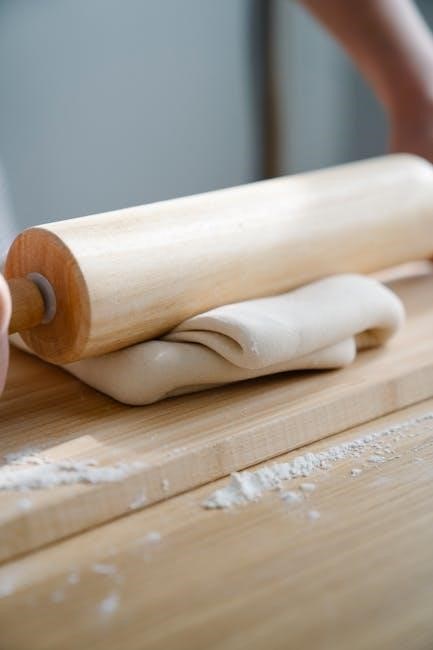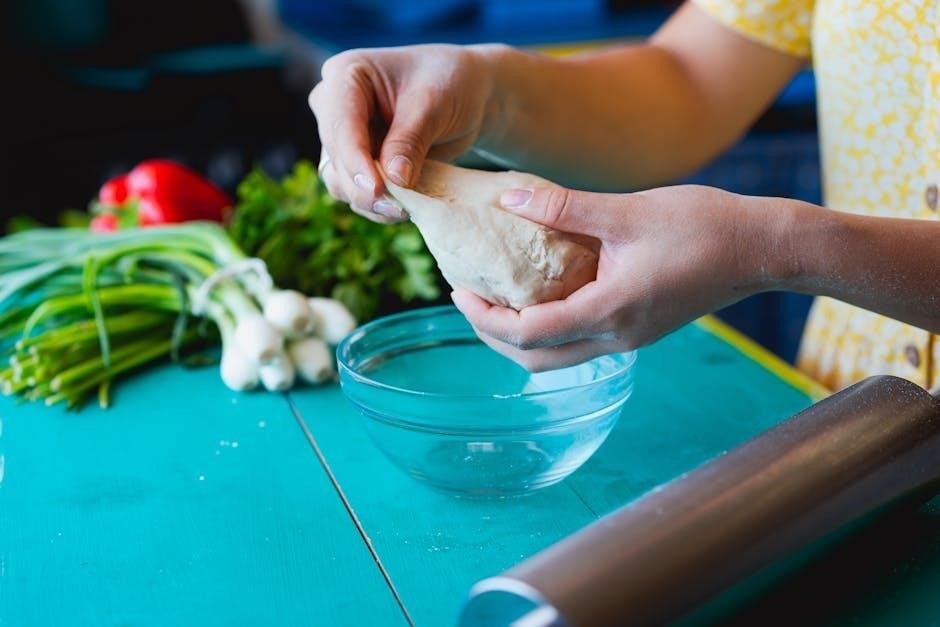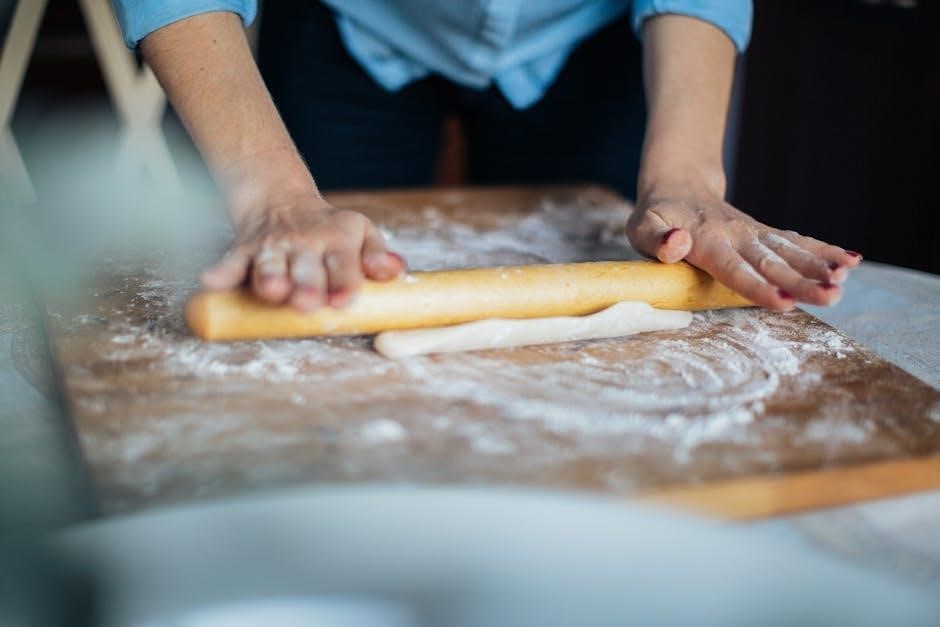Rolling pin thickness guides are essential tools for achieving consistent dough thickness, ensuring even baking results. They come in various forms, including adjustable rings or fixed measurements, and are designed to help bakers maintain precise control over dough rolled out to specific heights. These guides are especially useful for delicate pastries, cookies, and bread, where uniform thickness is critical for proper texture and flavor development. By using thickness guides, bakers can eliminate guesswork and achieve professional-quality outcomes effortlessly. Whether you’re a novice or an experienced baker, these tools enhance precision and simplify the rolling process.
What Are Rolling Pin Thickness Guides?
Rolling pin thickness guides are tools or features designed to help bakers achieve precise dough thickness while rolling. They can be adjustable rings, fixed measurements, or separate accessories that attach to the rolling pin. These guides ensure consistent thickness, which is crucial for even baking, especially for pastries, cookies, and bread. Made from materials like stainless steel, silicone, or wood, they often include etched markings or removable rings to accommodate various recipe requirements. Some guides are integrated into the rolling pin itself, while others are standalone accessories. Their primary purpose is to eliminate guesswork, allowing bakers to roll dough to the exact height needed for perfect results.
Why Are Thickness Guides Important for Baking?
Thickness guides are vital for ensuring consistent dough thickness, which directly impacts the quality of baked goods. Uneven dough can lead to undercooked or overcooked areas, affecting texture and flavor. By maintaining precise thickness, bakers achieve uniform baking results, essential for delicate pastries, cookies, and bread. These guides also simplify layering in recipes like croissants or puff pastry, where evenness is crucial for flaky textures. Additionally, they reduce guesswork, especially for novice bakers, ensuring recipes turn out as intended. Professional bakers rely on them for consistency, making them an indispensable tool in both home and commercial kitchens. Their use elevates baking precision and overall outcomes.

Types of Rolling Pin Thickness Guides
Rolling pin thickness guides come in two main types: adjustable rings and independent guides. Adjustable rings attach to the rolling pin, offering versatility, while independent guides provide precise control.
Adjustable Rings on Rolling Pins
Adjustable rings are a popular choice for achieving precise dough thickness. These rings attach to the rolling pin and can be set to various heights, ensuring uniform results. Made from materials like stainless steel or silicone, they are durable and easy to clean. Brands such as Joseph Joseph and Topekada offer high-quality options with removable and adjustable rings, allowing bakers to customize thickness for different recipes. These rings are ideal for both novice and experienced bakers, as they eliminate guesswork and ensure consistent outcomes. Whether making cookies, pastry dough, or pizza crusts, adjustable rings provide the flexibility needed for diverse baking tasks. Their versatility makes them a practical addition to any baker’s toolkit.
Independent Thickness Guides for Rolling Pins
Independent thickness guides offer a standalone solution for achieving precise dough thickness without modifying the rolling pin itself. These guides are typically made of durable materials like stainless steel or plastic and come in sets with multiple height options. They can be placed on either side of the dough, providing a consistent reference point for rolling. Unlike adjustable rings, independent guides are universal and can be used with any rolling pin, offering flexibility for bakers who prefer different tools. They are especially useful for those who already own a favorite rolling pin but still want the benefits of controlled thickness. This simplicity and versatility make independent guides a practical choice for both home and professional bakers seeking precision.

How to Choose the Right Rolling Pin with Thickness Guides
Selecting the right rolling pin with thickness guides involves considering ease of use, durability, and included features like adjustable rings or non-stick surfaces for effortless dough rolling.
Key Features to Look For
When selecting a rolling pin with thickness guides, look for adjustable rings or fixed measurements to ensure precise dough control. Durable materials like stainless steel or hardwood are ideal for longevity. Non-stick surfaces prevent dough from sticking, while etched measurement guides offer additional precision. Ergonomic handles enhance comfort during use, and removable rings allow for easy cleaning. Some models include pastry mats with measurement markers, providing a comprehensive baking solution. Consider the ease of adjusting thickness settings and whether the guides are removable for versatility. A sturdy construction and smooth rolling mechanism are also crucial for consistent results. These features collectively ensure accurate dough thickness, making baking tasks more efficient and enjoyable.
Material and Durability Considerations
Rolling pins with thickness guides are crafted from various materials, each offering unique benefits. Stainless steel models are durable, resistant to scratches, and easy to clean, making them ideal for heavy use. Wooden rolling pins, such as those made from beech or maple, provide a traditional feel and often feature etched measurement guides for added precision. Silicone or rubber rings are flexible and gentle on dough, reducing the risk of sticking. Durable materials ensure longevity, while non-stick coatings further enhance performance. When choosing, consider ease of maintenance and resistance to wear. A well-crafted rolling pin with sturdy thickness guides will withstand frequent use and remain a reliable tool in your baking arsenal for years to come.
Popular Rolling Pins with Thickness Guides
Top choices include the Joseph Joseph Adjustable Rolling Pin and Topekada Adjustable Rolling Pin with Pastry Mat Set. Both feature stainless steel construction, adjustable rings, and non-stick surfaces for precise dough control and effortless baking.
Joseph Joseph Adjustable Rolling Pin
The Joseph Joseph Adjustable Rolling Pin is a standout choice among bakers, offering exceptional precision and durability. Designed with removable stainless steel thickness rings, it allows for effortless adjustment to achieve the perfect dough height. The non-stick surface ensures that dough doesn’t adhere, making the rolling process smooth and efficient. Its ergonomic handle provides a comfortable grip, reducing fatigue during extended use. Additionally, the pin features etched measurement guides, offering both inches and centimeters for universal convenience. Ideal for both novice and experienced bakers, this rolling pin is versatile, catering to various baking needs, from delicate pastries to hearty bread. Its sleek design and high-quality materials make it a long-lasting addition to any kitchen.
Topekada Adjustable Rolling Pin with Pastry Mat Set
The Topekada Adjustable Rolling Pin with Pastry Mat Set is a comprehensive baking solution designed for precision and convenience. This 17-inch stainless steel rolling pin features removable thickness rings, allowing bakers to achieve uniform dough thickness effortlessly. The set includes a non-stick pastry mat, a pastry brush, and additional tools, making it ideal for rolling out dough for cookies, pastries, and bread. The mat’s measurements and guides help ensure accuracy, while the non-stick surface prevents dough from sticking. Durable and easy to clean, this set is perfect for both professional and home bakers. Its adjustable design and included accessories make it a versatile and practical choice for achieving consistent baking results.

Tips for Using Rolling Pin Thickness Guides Effectively
Use rolling pin guides to ensure even dough thickness for consistent baking results. Align the rings carefully, apply gentle pressure, and store them clean to maintain accuracy.
Ensuring Even Dough Thickness
Achieving even dough thickness is crucial for consistent baking results, and rolling pin thickness guides make this process straightforward. By using adjustable rings or fixed measurements, you can precisely control the height of your dough. This prevents uneven baking, where some areas may be undercooked or overcooked. For delicate pastries and cookies, maintaining uniform thickness ensures the right texture and flavor. To use the guides effectively, lightly flour the dough to prevent sticking and apply gentle, consistent pressure while rolling. This method also helps in achieving uniform rising for bread and pastries. With rolling pin thickness guides, you can eliminate guesswork and ensure professional-quality outcomes for all your baked goods.
Cleaning and Maintaining Your Rolling Pin Guides
Regular cleaning and proper maintenance of rolling pin thickness guides are essential to ensure they remain effective and durable. After use, wash the guides with mild soap and warm water, avoiding harsh chemicals that could damage materials. For stainless steel or silicone parts, a soft cloth can be used to wipe away dough residue. Dry thoroughly to prevent rust or mold buildup. Sanitize the guides periodically with a food-safe solution. Store them in a dry place to maintain their shape and functionality. Over time, check for wear and tear, such as bent rings or faded measurements, and replace them as needed to ensure consistent results. Proper care extends the lifespan of your rolling pin guides, keeping them accurate and reliable for future baking tasks.

Frequently Asked Questions About Rolling Pin Thickness Guides
Common questions include whether adjustable rings or fixed guides are better and if they can be used for both baking and cooking. These tools enhance baking precision and versatility, making them invaluable for achieving consistent results in various culinary tasks.
Do I Need Adjustable Rings or Fixed Guides?
Choosing between adjustable rings and fixed guides depends on your baking needs. Adjustable rings offer versatility, allowing you to roll dough to various thicknesses, ideal for recipes requiring precise measurements. They are especially useful for multi-purpose baking, such as cookies, pie crusts, and bread. Fixed guides, on the other hand, provide consistent results for specific tasks, like rolling dough for pasta or uniform cookies. If you bake frequently and need flexibility, adjustable rings are a better option. For simplicity and consistent results in specialized baking, fixed guides are preferable. Consider your recipes and frequency of use when deciding which type suits your baking routine best.
Can I Use Thickness Guides for Both Baking and Cooking?
Thickness guides on rolling pins are primarily designed for baking but can also be useful in cooking. For baking, they ensure even dough thickness for cookies, pastries, and bread. In cooking, they can help with tasks like rolling pasta dough or preparing uniform dumpling wrappers. Adjustable rings are particularly versatile, allowing you to achieve precise thickness for various recipes. Fixed guides are better suited for specific tasks, like maintaining a consistent thickness for pasta sheets. While their primary function is baking, they can extend to cooking applications where uniformity is key. Choose the type that best fits your needs, whether for baking or general kitchen use.

Leave a Reply
You must be logged in to post a comment.